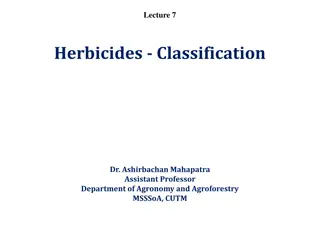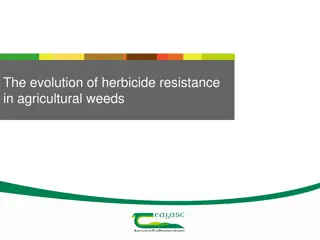Integrating Herbicides with Non-Chemical Weed Management Methods
The concept of weed management involves methods to enhance crop growth while discouraging weed invasion. Evolution shows the progression from manual labor to chemical methods. Weed management principles include eradication, prevention, and control. Eradication involves complete removal of weeds, whi
1 views • 34 slides
Understanding Adjuvants and Herbicide Formulation in Agriculture
Adjuvants play a crucial role in enhancing the effectiveness of herbicides by aiding in wetting, spreading, and penetration of herbicides into target plants. Different types of adjuvants such as surfactants, stabilizing agents, coupling agents, humectants, and deposit builders serve specific functio
2 views • 10 slides
Understanding the Fate of Herbicides in Soil
The fate of herbicides in soil is influenced by factors such as micro-organism decomposition, chemical decomposition, photodecomposition, adsorption by soil, surface runoff, leaching, plant uptake, and volatilization. Micro-organisms like algae, fungi, actinomyces, and bacteria play a crucial role i
6 views • 7 slides
Understanding Herbicide Mixtures, Compatibility, and Applications in Agriculture
Herbicide mixtures play a crucial role in weed control by combining different herbicides for enhanced efficacy. Various types of herbicide mixtures, including factory pre-mix and tank mix, offer advantages such as broad-spectrum weed control and delayed resistance development. Compatibility of herbi
3 views • 23 slides
The Benefits of Organic Goat Mowing for Your Lawn
Discover the advantages of using goats for lawn mowing, including cost savings, environmental benefits, weed control, and natural fertilization. Goats offer a sustainable and efficient way to maintain your property while reducing the need for pesticides and herbicides. Embrace a greener approach to
2 views • 14 slides
Introduction to Mode of Action of Herbicides and Selectivity
Explore the fascinating world of herbicides by delving into their mode of action, from absorption to plant death. Learn how different herbicides target specific plant processes, such as disrupting cell membranes or inhibiting photosynthesis. Understand the importance of application methods and the v
4 views • 35 slides
Overview of Herbicides Classification and Groups
Herbicides are classified based on their chemical nature into inorganic and organic types. Inorganic herbicides, such as arsenic acid and copper sulfate, do not contain carbon atoms, while organic herbicides, like glyphosate and 2,4-D, contain carbon atoms. The classification includes various groups
4 views • 15 slides
North America Crop Protection Chemicals Market
North America Crop Protection Chemicals Market by Type (Synthetic [Herbicides, Insecticides], Biological [Bioinsecticides, Bioherbicides]), Formulation (Liquid, Dry), Mode of Application (Seed Treatment, Soil Treatment), Crop Type - Forecast to 2030\n
7 views • 4 slides
Best Pharma Agriculture Near Me
Best Pharma Agriculture Near Me\n\nFinding the Best Pharma Agriculture Providers Near You\nDiscover top-quality pharma agriculture providers in your area to elevate your farming practices. From herbicides and fungicides to fertilizers and seeds, find the best solutions to boost your crop productivit
0 views • 1 slides
Understanding Pesticide Chemistry and Their Importance in Agriculture
Pesticides are essential for controlling pests, diseases, and microbes that harm plants. They include insecticides, herbicides, rodenticides, bacteriocides, nematocides, molluscides, algicides, and fungicides. Integrated pest management is crucial for effective pest control in agriculture.
0 views • 89 slides
Propionic Acid Market Ensuring Food Security
Propionic Acid Market, By Purity (Upto 99% and Above 99%), By Application (Animal Feed and Food Preservative, Sodium Salts, Herbicides, Plasticizers, and Other Applications), By End-User (Agriculture, Food and Beverage, Personal Care, Pharmaceuticals
0 views • 4 slides
Understanding Mycoherbicides: Effective Weed Control Using Fungal Pathogens
Mycoherbicides are biologically based agents derived from fungi to control weeds. They are cost-effective, stable, and environmentally friendly. History shows successful experiments in using mycoherbicides to combat invasive plant species. These agents work by releasing phytotoxins that kill target
0 views • 26 slides
Clariant AG's NBP Launch Marks a Milestone in Agricultural Adjuvants Innovation
Agricultural Adjuvants Market By Type (Activator Adjuvants and Utility Adjuvants), By Application (Herbicides, Insecticides, Fungicides, and Others), By Crop (Cereal & Grains, Oilseeds & Pulses, Fruits & Vegetables, and Others), By Region and Compani
0 views • 4 slides
Understanding Adjuvants and Herbicide Formulation
Adjuvants are additives that enhance herbicide effectiveness, crucial for optimal weed control. Types include surfactants, stabilizing agents, coupling agents, humectants, deposit builders, and more. Surfactants aid in wetting and spreading herbicides, stabilizing agents keep suspensions intact, cou
0 views • 10 slides
Overview of Herbicides Classification and Chemical Nature
Herbicides are classified based on their chemical nature into inorganic and organic herbicides. Inorganic herbicides do not contain carbon atoms, while organic herbicides contain carbon atoms. They are further categorized into 31 classes, each with distinct properties and modes of action. This class
0 views • 15 slides
Understanding Organophosphate Insecticides in Veterinary Pharmacology & Toxicology
Organophosphate insecticides, discussed by Dr. Kumari Anjana, Assistant Professor at Bihar Veterinary College, have a significant impact in controlling pests. These compounds inhibit cholinesterase enzymes, and their uses span across various applications including insecticides, acaricides, and herbi
0 views • 23 slides
Sustainable Management of Solar Farm Ground with Sheep
Utilizing sheep to manage vegetation at solar farms can reduce maintenance costs, carbon footprint, and reliance on herbicides. The natural grazing of sheep promotes a healthy ecosystem, stimulates the local economy, and provides a sustainable solution for solar farm ground cover.
0 views • 14 slides
Herbicide Absorption and Translocation Mechanisms in Plants
Herbicides need to be effectively absorbed and translocated within plants to interfere with physiological and biochemical processes. Soil-applied herbicides are absorbed by roots, shoots, and seeds through different mechanisms, while foliage-applied herbicides enter through the cuticle, stomata, and
0 views • 7 slides
Understanding Herbicide Resistance in Agricultural Weeds
This comprehensive content covers the evolution of herbicide resistance in agricultural weeds, including the origins of herbicides, cases of resistance, target site resistance, and non-target site resistance. It explains the definition of weeds, types of herbicides, selective and non-selective herbi
0 views • 32 slides
Understanding Pest Control and Types of Pesticides
Pest control is crucial to safeguarding health and property by managing pests like rodents, insects, and more. Various pest control methods are utilized to alleviate infestations. Moreover, different types of pesticides, such as insecticides and herbicides, are employed for pest management, each wit
0 views • 13 slides
Global Herbicide Resistance Action Committee (HRAC): Protecting Crop Yields Worldwide
The Global Herbicide Resistance Action Committee (HRAC) is a global leader in managing herbicide resistance to safeguard crop yields and quality. They focus on collecting, assessing, and providing vital information to combat herbicide resistance. Their mission is to support industry experts working
0 views • 12 slides
Understanding the Impact of Water Quality on Herbicide Efficacy
Water quality plays a crucial role in determining the effectiveness of herbicides. Factors such as water pH, hardness, turbidity, and dissolved materials can influence herbicide efficacy. The interaction between water chemistry and herbicide chemistry is essential for successful applications. Differ
0 views • 13 slides





















